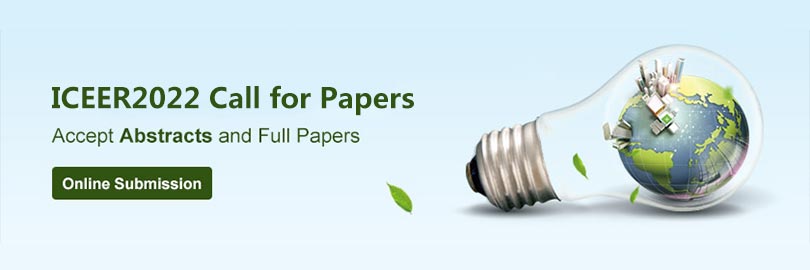2022 6th International Conference on
Energy, Environment and Resources
Important Dates
- Submission Deadline Extended: May 9, 2022
- Notification: 20-40 days after the submission
- Publication: 15-20 days after the final edition
- Conference Dates: May 28-30, 2022
Contact Us
-
 huiyi123net_may@126.com
huiyi123net_may@126.com
-
 021-51098086
021-51098086
-
 0086-18101720867
0086-18101720867
-
 2934920393
2934920393
-
 18101720867
18101720867
The information about the Keynote Speakers of ICEER2022 are as follows, which will be updated regularly.

Biography: Dr. Dong Luo is an Associate Professor at the School of Chemical Engineering and Light Industry, Guangdong University of Technology. He was obtained his PhD degree from School of Chemistry and Chemical Engineering, Shanghai Jiao Tong University in June 2018. He has been studying on cathode materials for lithium-ion batteries for more than 10 years since he studied for his master's degree in September 2010. Up to now, he has published more than 20 SCI papers as the first author or corresponding author, including Angew. Chem. Int. Ed., Adv. Energy Mater., ACS Energy Lett., Adv. Funct. Mater., J. Energy Chem. and Nano Energy etc.
Topic: Multi-structure Integrated Li-rich Mn-based Oxide Cathodes
Abstract: Li-rich Mn-based layered oxides (LLOs), especially for Co-free one, are one of the most promising cathodes to improve the energy density of Li-ion batteries (LIBs) over 350 Wh kg-1, which can meet urgent desire of electric vehicles for long duration and low cost. However, serious capacity fading and voltage decay hinders the practical application of LLO cathodes, which originates from surface-related changes, such as oxygen release, TM migration and dissolution, structural evolution and consumption of electrolyte. To this end, this speech will introduce how to construct a robust surface integrated structure for LLOs, and its influence mechanism on electrochemical performance.

Biography: Dr. Bin Bao is currently a Research Associate Professor at the Department of Mechanics and Aerospace Engineering of Southern University of Science and Technology in Shenzhen of China. He also works as Technical Consultant in Shenzhen Jiachen Technology Co., LTD, China. Based on his academic achievements, he has been honored with Vebleo Fellow Jr. He is a Senior Member of The International Institute of Acoustics and Vibration (IIAV), Chinese Society for Vibration Engineering and Chinese Mechanical Engineering Society. He was awarded the title of Senior Engineer in the Guangdong Province of China. His research interests span a wide range of topics in vibration and wave control based on piezoelectric materials and structures.
Topic: Piezoelectric Energy Harvesting for Low Energy Density Applications
Abstract: Traditional electromagnetic energy harvesting methods are hard to deal with collecting energy from low energy density applications. This speech will introduce several efficient piezoelectric energy harvesting approaches for low energy density applications to overcome this drawback, such as energy harvesting from small hydro, vehicles, and human motion. For example, a bladeless rotational piezoelectric energy harvester was proposed for hydroelectric applications of ultra-low and wide-range flow rates. The proposed harvester makes full use of the advantages of piezoelectric materials and the ancient Chinese Qiqi structure. It overcomes the difficult problem in harvesting liquid energy with (ultra) low energy density through the working principle of intermittent periodic power generation.

Biography: Dr. Jinjin Yan is an Associate Professor at the College of Intelligent Systems Science and Engineering, Harbin Engineering University. He graduated and obtained his PhD degree from Faculty of Built Environment, UNSW in November 2020. He was a member of the Geospatial, Research, Innovation and Development (GRID) lab in UNSW. He finished his master’s degree (2013-2016) and bachelor’s degree (2009-2013) in the Faculty of Information Engineering, China University of Geosciences in Wuhan. Since October 2016, he started his PhD research in the 3D GeoInformation group at the Department of Urbanism, Delft University of Technology. In February 2018, he transferred to UNSW. He currently is focusing on 3D modelling, 3D space-based navigation, 3D analysis of spaces, 3D space subdivision, seamless indoor and outdoor navigation, BIM and GIS integration, path planning algorithms, Mobility as a Service (MaaS), super navigation network.
Topic: 3D Space-based Seamless Path Planning in Indoor and Outdoor
Abstract: Contemporary living environments are getting more and more complex, combining structures indoor and outdoor. These structures can be broadly subdivided into entirely bounded (indoor), partially bounded (semi-bounded), and unbounded (outdoor). Normally, agents (e.g., pedestrians) wish to have seamless navigation when seamlessly transferring from one kind of environment to another and back. This research developed new theories, models, and approaches to support seamless navigation in all kinds of environments, which include a novel generic space definition framework, a unified 3D space-based navigation model, approaches for automatically reconstructing 3D spaces, and four new path options (MTC-path, NSI-path, ITSP-path, and indoor FD-path). This research brings in four contributions to seamless navigation: (i) living environments (spaces) are systematically categorized and defined as indoor (I-space), semi-indoor (sI-space), semi-outdoor (sO-space), and outdoor (O-space); (ii) all types of spaces are uniformly modeled and managed as 3D spaces, thereby sharing the same approaches for deriving navigation networks; (iii) sI-spaces and sO-spaces are included in navigation maps, which allows developing new path options based on them; and (iv) on the basis of 3D spaces, vertical constraints are considered in navigation path planning.
Copyright © 2016-2022 6th International Conference on Energy, Environment and Resources - All rights reserved.

